In modern biological research and production, cell shake flasks play an indispensable role as a key cultivation tool. Their unique triangular structure, when used in conjunction with a shaker, provides an ideal environment for cultivating suspension cells.
1. Unique Structure and Function of Cell Shake Flasks
The triangular design of cell shake flasks enables effective mixing of the culture medium during shaking. This is crucial for the uniform growth of suspension cells. The shaking action prevents cells from settling at the bottom of the flask, ensuring that the cells remain evenly distributed throughout the culture medium. This design not only enhances the efficiency of the culture process but also optimizes the growth environment for the cells.
2. Cultivation of Suspension Cells
Tumor Cells: Many tumor cell lines, such as HeLa cells and K562 cells, are adapted to grow in liquid culture medium. Cell shake flasks provide a stable suspension environment that effectively supports their high-density cultivation and large-scale production.

Blood Cells: Blood cells, particularly red and white blood cells, are typically cultured in liquid media for expansion. The shaking of the cell shake flask mimics the flow of blood in the body, helping to maintain cell activity and function, which is important for their proper growth and development.
Microbial Cell Lines: Certain microbial cell lines, such as yeast and some bacterial strains, also require suspension culture. Cell shake flasks ensure the uniform mixing of the culture medium, thereby promoting the growth and metabolic activity of these microorganisms.
Conclusion
Cell shake flasks are not only widely used in academic research but also play an important role in the pharmaceutical and biotechnology industries. Their efficient mixing and culturing capabilities make them an ideal choice for suspension cell culture, providing strong support for both biological research and industrial applications.
The FAI climbed 5.9 percent year-on-year in the first 11 months of 2018, quickening from the 5.7-percent growth in Jan-Oct, the National Bureau of Statistics (NBS) said Friday in an online statement.
The key indicator of investment, dubbed a major growth driver, hit the bottom in August and has since started to rebound steadily.
In the face of emerging economic challenges home and abroad, China has stepped up efforts to stabilize investment, in particular rolling out measures to motivate private investors and channel funds into infrastructure.
Friday's data showed private investment, accounting for more than 60 percent of the total FAI, expanded by a brisk 8.7 percent.
NBS spokesperson Mao Shengyong said funds into weak economic links registered rapid increases as investment in environmental protection and agriculture jumped 42 percent and 12.5 percent respectively, much faster than the average.
In breakdown, investment in high-tech and equipment manufacturing remained vigorous with 16.1-percent and 11.6-percent increases respectively in the first 11 months. Infrastructure investment gained 3.7 percent, staying flat. Investment in property development rose 9.7 percent, also unchanged.
 English
English


















































